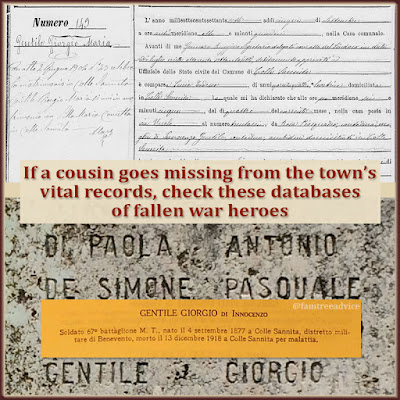Once in a while I revisit my list of genealogy website bookmarks. When I saved each link, it either inspired me or seemed like a useful resource.
Today I decided to squeeze the value out of one of these bookmarks. It's a database of Italian war dead—both World War I and II. I'm sure we all have people in our family trees who disappeared from the records. If they were the right age at the right time, they may have died in the war.
An Italian Example
To explain how to use these databases of war dead, I'm going to focus on an Italian casualty website. But there are other databases below that may work better for you.
 |
| I know many of these fallen heroes belong, or are already in my family tree. |
At the website www.cadutigrandeguerra.it:
- I clicked Richerche (research).
- This page has a form with a ton of boxes.
- I filled in only one: Comune in Albo. Since the bulk of my relatives came from one town, I entered that town into the field: Colle Sannita.
- Instead of a town, you can enter a name in the 1st box: Nominativo e paternità. Enter only a last name, or a full name, but last name first, like Russo Giovanni.
- My search produced a list of 96 men from the town who died in World War I.
- Almost every last name in the list is familiar to me, so I started down the list, searching for each man in my family tree.
It took a while to find one, but when I did, I knew he was the right man because:
- The database includes the name of each man's father, and that was a match.
- The database include each man's birth year, and that was a match.
I already knew that Giorgio Gentile, son of Innocenzo, was born in Colle Sannita on 4 September 1877. He married Maria Concetta Pilla on 2 June 1902, and they had a son, Innocenzo, on 13 April 1903. Now I've learned that:
- Giorgio died in 1918 at home in Colle Sannita from disease.
- He was a soldier in the 67th battalion.
- A link to a printed list of war dead confirms his birth date. (The link says Mostra Pagina—Show Page.)
- The linked page provides his exact death date: 13 December 1918. It also confirms his exact birth date.
- Giorgio was 41 years old and fulfilling his military service when he died.
Now I have all the vital information for Giorgio: birth, marriage, and death. I felt sure Giorgio and Maria Concetta had more than one child. So I searched the available vital records.
There are no birth records available for 1905 through 1909. But I found his children Paolo, born in 1910, and Lucia Rosa, born in 1915. Lucia Rosa's birth record has a note written later in the column. It says, "The father [of this child] died in the national war as per communication from the Ministry of War dated 1920."
Giorgio's records are as complete as they can be. That couldn't have happened without this database. I'll continue down this list of 96 war dead from my Grandpa's town. Then I'll search my handful of other towns.
 |
| With online databases of the war dead, I can identify the men named in their hometowns' monuments. |
Search Other Countries
To search for your fallen family members, try these databases:
- British Commonwealth, World War I and II: https://www.cwgc.org/find-records/find-war-dead provides name, rank and, service number; unit, rank, and country of service; date of death and age; burial place; next of kin and their address; and a commemorative document.
- Germany, World War I: https://www.ancestry.com/search/collections/2124 provides an image of the casualty lists, printed in German, with name, place of birth, and the date of the list.
- United States, World War II: https://www.ancestry.com/search/collections/1102 provides rank, branch of service, burial place, and an image of their name in the "Roster of World War II Dead."
- United States, World War II: https://www.militaryindexes.com/worldwartwo provides access to many online resources. Look for "World War II Records by State" for lists of the dead and wounded.
- Various countries, World War I: http://www.greatwar.co.uk/research/military-records provides links to country-specific databases like the Italian one I'm using.
- Various countries, World War II: https://www.archives.gov/research/military/ww2 provides free access to many lists, photographs, maps, recordings, and more.
Need more? Search online for "database of world war dead," or make that more specific to what you'd like to find.
I'm sure you'll agree it's worthwhile to find out what became of some of the men in your family tree. Many towns in Italy have monuments to their fallen soldiers. I photographed the memorials in my ancestral hometowns. Now I should have enough information to tie names on the monuments to people in my tree.
And speaking of military records:




